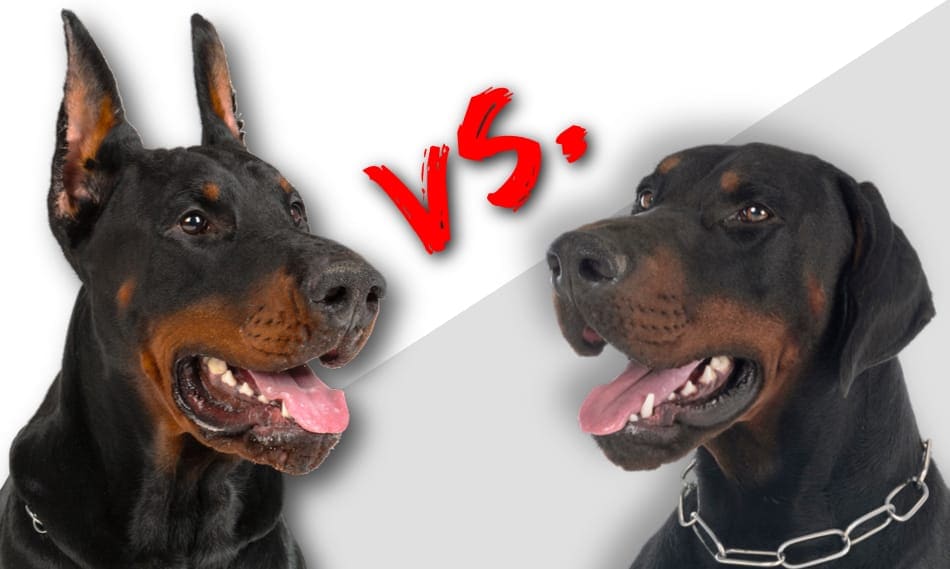
Whether or not you should crop your Doberman Pinscher’s ears is one of those topics I write about on this site that certainly gets a lot of controversy from people on both sides of the debate. It’s my hope in this article to outline the real-world pros and cons of getting your Doberman’s ears cropped, along with my experience with my Dobermans, so you can decide what’s best for you and your dog.
There is no requirement stating owners have to crop their Doberman’s ears. In fact, many Doberman owners decide to leave their dog’s ears in their natural state. While the Doberman breed standard in the United States calls for Dobermans to have cropped ears, this is only of concern if you plan to enter your dog in AKC breed conformation shows.
In other words, there is no right answer here and owners can do what they please. There is no regulation or law anywhere that I am aware of (certainly not in the U.S.) requiring you to crop your Doberman’s ears. In some areas, however, there are laws against it. Although the Doberman Pinscher Beed Standard as published by the American Kennel Club does call for cropped ears on the Doberman, this only matters if you’re showing your dog in breed conformation shows. Otherwise, it will likely have no bearing on your decision.
Table of Contents
PLEASE NOTE: In this article, I will present the potential pros and cons of ear cropping Dobermans as argued by those who are both for, and against it. The opinions and statements in the pros and cons sections in this article aren’t necessarily representative of the author’s opinions. They are presented here so you can make up your own mind.
Pros – The Arguments for Ear Cropping
Below are some of the most common arguments made by those who are for the ear cropping of Dobermans as to the potential benefits of the procedure.
1. Improved Sound Localization
Many argue that there are no examples of dogs in the wild who have floppy ears due to natural selection. The Doberman breed is a man-made creation, just like most dog breeds in existence, and they have many features that would never occur in the wild. One example of this is floppy ears.
Ear cartilage that hangs down in front of the ears can obstruct sound from entering the ear canal as efficiently as it otherwise would if the dog had erect ears. Having an unobstructed path for sound to travel the ears can increase hearing and even the ability of the dog to locate the source of a sound.
2. The Traditional Doberman Look
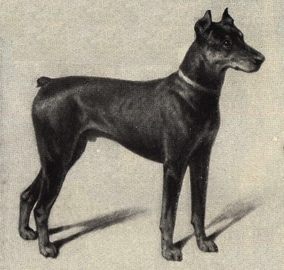
The Doberman breed was created in the 1890s by a German tax collector, night watchman, and local dog catcher named Karl Friedrich Louis Dobermann. He wanted to create a dog breed that was ideal for personal protection.
The dog he ultimately created through selective breeding is the dog we know today as the Doberman. His original dogs always had cropped ears and a docked tail. This was so they could excel at their primary purpose—guard work.
This look has caught on and now a Doberman with erect and cropped ears is widely considered to be the “traditional” look for a Doberman. Die-hard breed fanatics often argue that you aren’t raising a Doberman in the image originally intended by the creator of the breed if you have a Doberman without cropped ears.
3. Less Ear Infections
One of the most common underlying causes for an ear infection is excessive moisture (source). Ear cropping and posting procedures will open up the ear and drastically increase airflow into the ear canal. This can lead to a drier ear overall and potentially fewer ear infections.
One study done on 2,012 dogs in Nova Scotia showed that the prevalence of ear infections in floppy-eared dogs was significantly higher than in dogs with erect ears. In the dogs studied 17.8% of the dogs with “pendulous ears” (i.e. floppy ears) were diagnosed with a type of ear infection whereas only 12.8% of dogs with erect ears were (source).
4. It’s the Breed Standard
The Doberman Pinscher breed standard in the United States is set by the American Kennel Club (AKC). The breed standard states that the Doberman Pinscher should have ears that are cropped and held in an erect position. Other countries follow a different breed standard such as the Federation Cynologique Internationale (FCI) which has no such requirements.
Frankly though, to the average owner of a Doberman who just wants a family dog and has no intention of having their dog compete in the show ring, having their dog fit the breed standard likely isn’t of any concern to them.
5. Easy Recognition as a Doberman
Dobermans with cropped ears are more quickly recognized as a Doberman, at least in the United States where ear cropping of Dobermans is so incredibly common. Whereas a Doberman with floppy ears is often misidentified by others as a type of hound dog, mutt, or an unknown breed.
Being able to be quickly identified as a Doberman can make it less likely for someone to challenge the dog due to the Doberman’s reputation for fearlessness, loyalty, and protectiveness over their owners.
6. Better for Guard or Protection Work
The creator of this breed, Karl Friedrich Louis Dobermann originally cropped his dog’s ears so that they could excel at protection work. Having cropped ears made for one less hand-hold for an attacker to grab on to and gain control over the dog.
Having shorter, smaller ears that naturally laid back over the top of the dog’s head like cropped ears will do, means there is a lesser chance of damage to the ear by a person or other dog during a conflict. It also allows the dog to be more quickly identified as a Doberman (as per the previous point) and gives them a more alert appearance. Both of which can deter a potential attacker.
7. Protects Against Future Ear Injuries
Many working dogs like hunting dogs, for example, will have their ears cropped if they’re expected to be running through thick brush or quickly past other obstacles that could injure their ears.
Also, when a Doberman has any type of ear irritation, they’ll often violently shake their head side-to-side. They can do this so repetitively at times, that the tips of the ear can begin to bleed and have difficulty healing. Many argue that this is less likely if the dog has cropped ears.
Cons – The Arguments Against Ear Cropping
Here are some of the potential drawbacks, or downsides, to getting your Doberman’s ears cropped as argued by those who are against ear cropping.
1. Surgery Risks
Every surgery inherently involves some level of risk to your dog and for an ear cropping procedure, your Doberman will almost certainly be under full (or “general”) anesthesia which involves a higher level of risk. Although rare, there is a long list of potential complications that can happen during an ear cropping procedure such as infections or even death.
2. Discomfort or Pain
Any medical procedure will almost certainly involve some level of pain or discomfort on a dog. During the surgery itself, it’s unlikely the dog will experience any pain due to the use of general anesthesia (the dog will be unconscious). But there is certainly some level of pain and discomfort afterward. How much pain is hotly debated by both sides of this issue.
In my experience with my Dobermans, I have never noticed pain around the time of the surgery. But as the pain medications wear off, at times my dogs would shake their heads, and try to scratch at their ears. It’s unknown how much of this is because of the bandages they’re wearing annoying them and how much is due to discomfort.
Where I’ve noticed the most pain from my Doberman pups is when the stitches are removed or the first bandage change occurs after surgery. Depending on the technique used by the veterinarian, there is at times crying and/or whimpering during these stages, although not always.
After that, your dog’s ears will need to be posted in position usually until their ear cartilage firms up (usually at 6 to 8 months of age). The bandages and earn posts can be annoying and uncomfortable for the dog although it doesn’t seem likely that they cause any pain.
3. Not Medically Necessary
Ear cropping in modern times is almost never medically necessary. There are a few cases where a veterinarian might advise that it is, and usually, this is only in the case of a severely damaged ear from an accident, dog attack, or medical condition.
Many argue that putting your dog through a surgery that they don’t medically need is immoral. Certainly this can be seen as one downside to this procedure.
4. Ear Posting is Difficult
After the surgery is completed, the ear cartilage needs to heal and the ear will need to be “posted” in position so that when the ear cartilage hardens naturally with age, the ears will stay in the correct position. This will take a significant amount of time and effort on the part of the owner to maintain these ear posts.
For example, typically every 3 to 5 days the bandages will need to come off, posts removed, and ears cleaned. Then the posts and bandages will need to be replaced so the ears are positioned correctly.
Owners will often do this more frequently if the ears get wet or dirty, or less frequently if they stay fairly clean. This schedule of wrapping and cleaning the ears will need to continue until the dog is at least 6 months old but at times can be necessary up until the dog is 1 year of age.
5. Limits Their Expressiveness
Like all dogs, Dobermans will communicate with other dogs and humans through various means including the use of their ears, tail, body movements, and more. When you reduce or eliminate the ability for them to use their ears to communicate how they’re feeling, it can lead to misunderstandings of behaviors.
Some argue that cropped-eared dogs get into more dog fights because how they’re feeling during a given interaction isn’t adequately communicated to the other dogs.
6. Makes Them Less Approachable
The general perception of a cropped Doberman thanks to movies and television is that they’re more aggressive and potentially dangerous than if they have floppy ears.
In fact, one study on the perception of various dogs by 392 study participants published in 2016 determined that modified dogs (those with cropped ears and docked tails) were seen as more aggressive towards other people and other dogs, and more dominant. Doberman Pinschers with cropped ears and docked tails were seen by participants as being about 13% more likely to be aggressive towards other people and dogs as compared to those with natural ears and tails (source).
In the real world, this means that you’ll see more families crossing the street to get out of your way while you’re walking your dog, fewer people approaching you to interact with your dog (this could negatively affect their socialization), and more hesitations about the dog from friends and family.
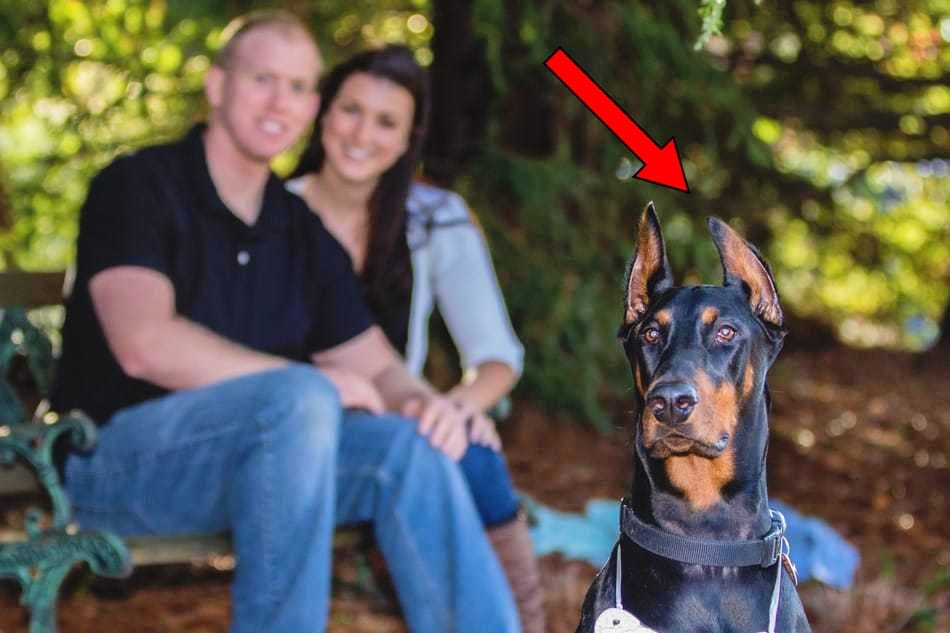
7. The Proceedure is Not Always Successful
There’s always a chance that cropping your Doberman’s ears will not be successful. How often it’s not successful is almost impossible to determine as every veterinarian has a different definition of what a successful crop is. Sometimes the ears will both stand but other times one ear may be crooked. Other times neither one may stand. Although the success of the ear cropping seems to depend heavily on the consistency and technique of the ear posting by the owner.
However, there are things you can do to increase your chances like going to a reputable veterinarian experienced in Doberman ear cropping, posting for the appropriate length of time after surgery (not stopping posting early), and getting the dog cropped at an ideal age (usually between 7 and 9 weeks of age).
8. Judgement from Others
There are many people out there who believe that cropping a dog’s ears is cruel and inhumane. This is especially true outside the United States. So you may get the occasional comment about how you “mutilated” your dog or how you don’t care about your dog because you choose to get their ears cropped.
This is especially true on social media where it’s easier for those in other countries to see your dog and then pass judgment.
Video: Cropped vs. Natural Eared Dobermans
The Doberman Breed Standard
Inside the United States
The Doberman Pinscher Breed Standard in the U.S. as put out by the American Kennel Club (available here) outlines what the ideal Doberman Pinscher should look like. It’s relied upon by judges in breed conformation shows when rating contestants and selecting the winners. The breed standard for the Doberman Pinscher, states the following:
“Ears normally cropped and carried erect. The upper attachment of the ear, when held erect, is on a level with the top of the skull.”
– Official Breed Standard of the Doberman Pinscher (The American Kennel Club)
Interestingly, however, the ears being left in their natural state is not listed as a disqualifier in this document, but it would be considered a fault due to the following line which appears later in the document:
“The foregoing description is that of the ideal Doberman Pinscher. Any deviation from the above described dog must be penalized to the extent of the deviation.”
Official Breed Standard of the Doberman Pinscher (The American Kennel Club)
So in other words, you can expect a Doberman in the show ring to get penalized for not having cropped ears, but it’s not an automatic disqualifier.
In Other Countries
The Federation Cynologique Internationale (FCI) is the largest canine organization in the world and they have divisions in Europe, the Americas, Caribbean, Asia, Africa, and Oceania. They too have a breed standard for the Doberman (available here). However, this standard does not require the Doberman’s ears to be cropped.
In fact, the FCI breed standard says the following in regards to the ears.
“The ears, are left natural and of an appropriate size; they are set on either side at the highest point of the skull and are ideally lying close to the cheeks.”
Federation Cynologique Internationale (AISBL) Standard No. 143 – Dobermann
Like the United States breed standard, falling outside what’s outlined doesn’t appear to be a disqualifier but is considered a fault. The following line appears further down in the document:
“Any departure from the foregoing points should be considered a fault and the seriousness with which the fault should be regarded should be in exact proportion to its degree and its effect upon the health and welfare of the dog and its ability to perform its traditional work.”
Federation Cynologique Internationale (AISBL) Standard No. 143 – Dobermann
How cropped ears are perceived by the kennel clubs inside the United States and other parts of the world are in stark contrast to each other. But realistically, falling outside of any of the breed standards only has consequences if you intend to show your dog in breed conformation shows.
Legalities of Ear Cropping
Due to the differences of perception of ear cropping of Dobermans and dogs in general between various countries and societies, it’s no surprise that there are very different laws on this subject depending on where you live. For example, in the United States, it’s legal as long as a veterinarian performs the procedure. Cropped ears are the norm at any Doberman club gathering or kennel club events where Dobermans are present inside the United States.
Whereas in other countries, it’s often either completely outlawed or only permitted if it’s medically necessary. The following map can give you a rough idea of where it may or may not be legal.
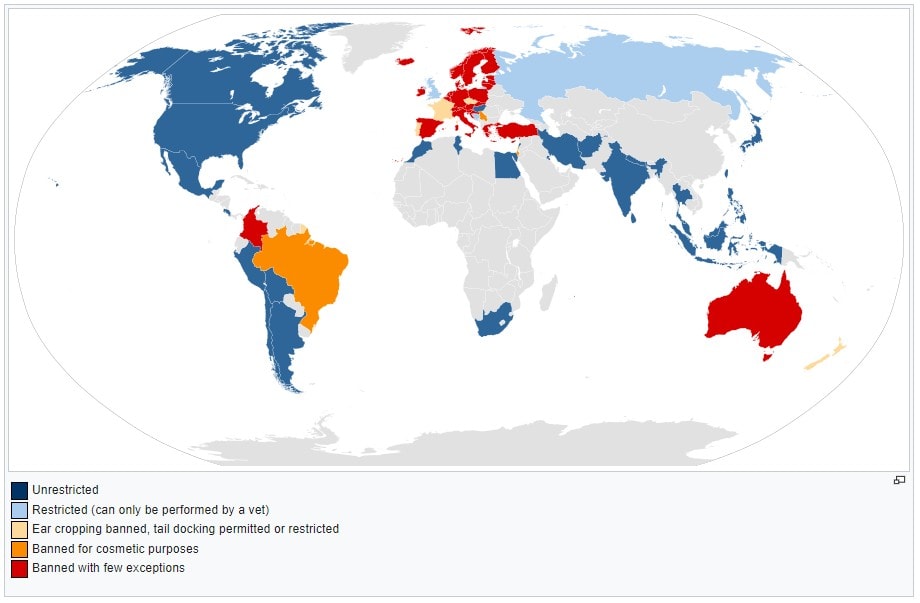
IMPORTANT NOTE: Although the map above is a good general reference, it’s important to do your own research in regards to legalities where you live, even if this map indicates it may be legal in your country. This map may not be complete, completely accurate, and may have outdated information. One example is although this map shows cropping as legal in Canada, readers have informed me that it’s illegal in many provenances within Canada (it’s only legal on the federal level).
Ear Cropping Proceedure
Although the ear cropping procedures can vary a bit depending on what vet you go to, the following seems to be a fairly consistent approach and experience that most Doberman have from what I’ve seen.
- Prepare for the Cost – In the U.S. ear cropping a Doberman costs on average between $300 and $800.
- Pick a Time to Do It – Ear cropping on Dobermans is done when the dog is between 7 and 9 weeks old. It can often be done up until about 12 weeks of age—but ask your vet to look at your dog’s ears to see if the cartilage has already hardened. See my article on when to crop a Dobermans ears for more information.
- Find a Veterinarian – Ear cropping should be done by a reputable veterinarian experienced in Doberman ear cropping specifically. Ask for photos, or see examples of other dogs they’ve done in the past. You may have to travel far to find a vet like this as fewer vets are doing this procedure in recent years. To get an idea of cost, you can see our article all about Doberman ear cropping cost where we received 11 real quotes from veterinarians to get our Doberman’s ears cropped.
- Pick a Style – Pick the ear crop style you want: short (military crop), medium, or long (show crop). All my dogs have had medium length crops and that seems to be the standard for most family Dobermans.
- Have the Proceedure Performed – The ear cropping proceedure is about a 30-minute procedure, and it’s done under general anesthesia. After the proceedure, your veterinarian may have a pain patch affixed to your dog or they may be on some slow-acting pain medications (or both). You may receive a few chewable pain medications to give to your dog for the first few days after surgery.
- Follow-up with Your Vet – After a week or two, the vet removes the stitches and it’s usually up to the owner after this point to keep the ears in the propert position by posting and wraping them. Your vet will likely give you information on how they suggest doing this.
- Owner Care – Approximately every 3 to 5 days, the owner will remove the ear posts, cleam, and inspect the ears. Then they will post them into position again using a new support and medical tape. This may occur more or less frequencly depending on how clean and dry the ear canal stays.
- Continue Posting Until the Ears Stand – The cleaning, posting, and re-wrapping is usally redone every few days until the ears stand reliably on their own (usually anywhere between 6 to 8 months). The longer the crop, the longer posting will be necessary. The idea of this is to hold the ear in the correct position until the ear cartilage naturally firms up enough to keep them in the upright position. Your dog’s ears naturally firm with age.
This is accurate to my experience but since it may vary, it’s important that you contact a reputable veterinarian experienced in this procedure and ask them how to proceed. Always follow your vet’s advice over any information listed here.
More information about the traditional method used in the past by veterinary surgeons to crop a dog’s ears can be found here.
Ear Cropping After Care
After a Doberman’s ears are cropped it’ll usually be the owner’s responsibility to perform posting of the ears until the dog is about 6 to 8 months of age. Although at times, this can go up until the dog is 1 year of age, depending on how long the ear cropping is and how fast the cartilage firms up. This involves wrapping, or posting, the ears into position until the dog’s ear cartilage naturally firms up causing them to stay erect.
The veterinarian that performs your dog’s ear cropping will provide you with direction on aftercare which should be closely followed. However, this is how the majority of aftercare is done for Doberman ear crops in my experience.
Every 3 to 5 days (or as needed):
- Remove ear postings.
- Clean the ears and check for any signs of redness, irritation, or infection.
- Replace ear postings.
NOTE: You may need to do this more often with your Dobie if they get their ears wet or particularly dirty.
It’s often fairly time-consuming to post a Doberman’s ears in the right position and it involves inserting a support into the ear (like a foam rod, cardboard, or plastic support), and then wrapping the ear to stay in place.
Replacing the ear posts on a Doberman can take 15 to 45 minutes depending on the specific technique that’s used and how experienced you are with the posting procedure. You’ll need to maintain this process until the dog’s ears can reliably and consistently stay standing on their own. Usually, this occurs when the dog is around 6 months of age, but it can be as late as 12 months of age if it’s a longer crop or the dog’s ear cartilage is slow to firm up.
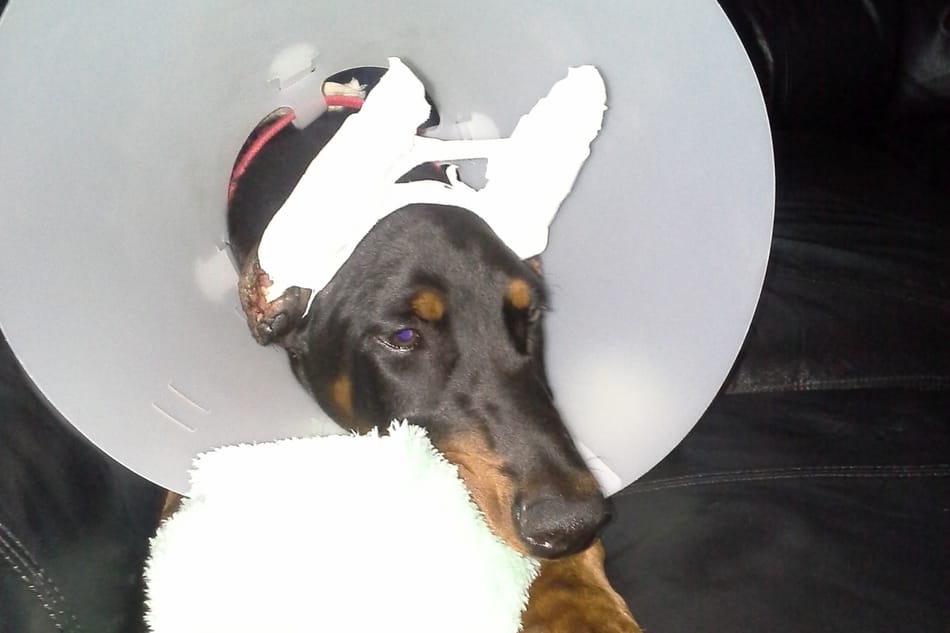
Cruel or Not Cruel
Ear cropping a Doberman for cosmetic reasons is considered cruel and unnecessary in many parts of the world. In other areas like the United States, ear croppings are commonplace, and cropped ears are still part of the breed standard for the Doberman Pinscher. It’s unclear at this time exactly how much discomfort or pain is experienced by the dog.
The question of whether ear cropping a Doberman is cruel or not is still vigorously debated by both sides. Many breeders and professional handlers of Dobermans will say that ear cropping is a fairly painless and relatively minor procedure, however, there’s an equal number of advocates who claim it’s painful and cruel to the animal. In 2008, the American Veterinary Medical Association (AVMA) released a statement advising that their organization is opposed to this procedure.
“The AVMA opposes ear cropping and tail docking of dogs when done solely for cosmetic purposes. The AVMA encourages the elimination of ear cropping and tail docking from breed standards.”
– The American Veterinary Medical Association, 2008 (Source)
Modern veterinarians do implore many pain management techniques to make the procedure as painless as possible including full anesthesia and pain medicine after the procedure. There are also newer techniques being used such as laser ear cropping that drastically reduces the healing time.
In my experience, it seems like Dobies have no problem handling the procedure itself and I’m always relieved when I see how happy and chipper my Dobermans are right after the procedure. Although to be fair, it’s likely that the pain medication is still in their system at the point when I first see them after surgery. The ear wrappings do, at times, seem to annoy the dogs as the months go by during the posting stage (but the ears are fully healed at this point).
In my personal experience, I’ve only seen what I would describe as true pain from any of my Dobermans at around the time of the first bandage change by the vet after the procedure. In the past, that has caused some whimpering from my dogs. However, I never saw anything remotely resembling pain on subsequent bandage changes, or during ear posting later on.
WHAT ABOUT TAIL DOCKING? Tail docking is a much easier, and cheaper, procedure done when the dog is much younger. To learn more about this, see my article all about Doberman tail docking pros and cons
FAQ
Why do Dobermans have their ears cropped? Dobermans often have their ears cropped to conform to breed standards, for cosmetic reasons, or for a role as a working dog. Shorter ears are considered less likely to be injured if the dog is involved in a conflict or running through thick brush. Many still question the ethics of this procedure.
Is ear cropping painful for a Doberman? Since Dobermans are stoic dogs, it’s unclear how much pain or distress is experienced by a Doberman who has had their ears cropped. Modern veterinarians implore many pain management techniques in an attempt to minimize the pain such as general anesthesia, pain medication, and laser ear cropping.
Can you post a Doberman’s ears without cropping? Posting a Doberman’s ears without cropping them is rarely done and is often not successful. A Doberman’s natural ears are large and heavy which makes it difficult to train them to stand if left uncropped.
How do you crop a Doberman’s ears? A Doberman’s ears are cropped by veterinarians familiar with the procedure under full anesthesia. Ear cropping should never be attempted at home or without anesthesia.
Where can you get a Doberman’s ears cropped? You can get Doberman’s ears cropped at a veterinarian who specializes in the procedure if permitted by your local laws.
How much does ear cropping cost? Cropping a Dobermans ears costs between $300 to $800 on average. Cost may vary depending on which veterinarian performs the procedure.


